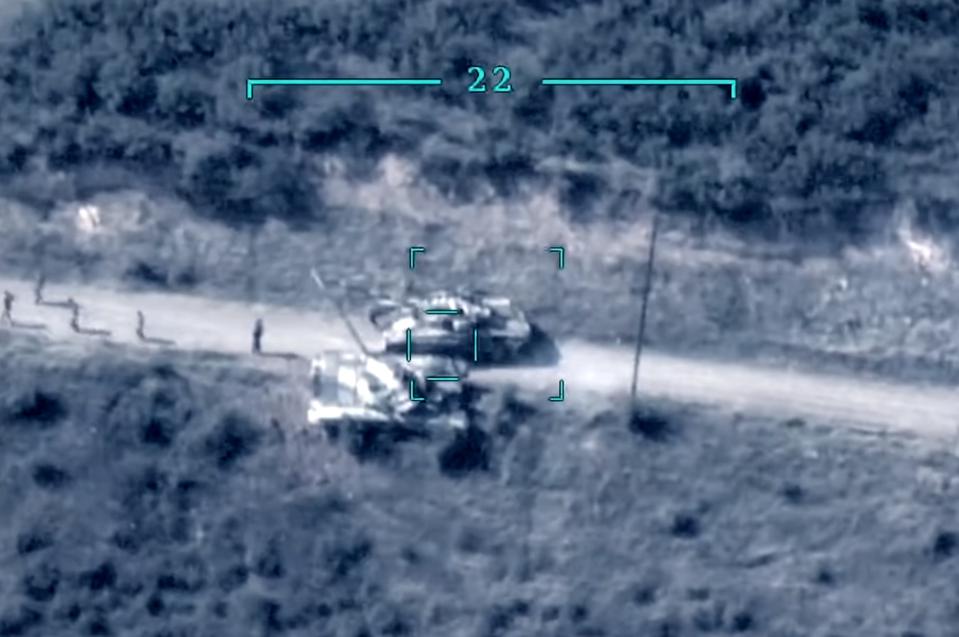The US is paying close attention to the successful military tactics carried out by Azerbaijan in the second Karabakh war, in which the Caspian country claimed a clear-cut victory over Armenia.
According to Defence.az citing Breaking Defense magazine, the United States Army Futures Command (AFC), a body that leads the modernization of the U.S. Army and the development of future combat systems, highly praised Azerbaijani tactics during the recent heavy clashes with Armenia's troops.
The magazine mentioned a new practice demonstrated during the second Karabakh war - using hi-tech 21st-century weaponry, including reconnaissance and strike drones, alongside traditional forces, such as tanks, infantry and artillery.
Speaking to the magazine on condition of anonymity, a general of AFC said the recent escalation in the Nagorno-Karabakh conflict between Armenia and Azerbaijan shows how the war of the future will be fought. And unmanned aerial vehicles play a key role in this process.
The source noted that the Azerbaijani Army used not only reconnaissance but also strike and suicide drones to quickly destroy Armenian armored vehicles in the Karabakh region, which enabled the Azerbaijani Army to quickly defeat Armenia's troops and move forward. Concerned over the feasible usage of similar tactics by the Chinese and Russian armies in a possible war against the U.S. in the future, the general stressed the necessity for the US Army to study the practice of such regional conflicts.
The clashes between the two South Caucasus neighbor countries Armenia and Azerbaijan sparked in late September after Armenia's troops deployed in the occupied Karabakh region of Azerbaijan began shelling heavily Azerbaijani military positions and civilian settlements. Experts note that the scale of hostilities, including the use of precision-guided weapons, has already exceeded previous escalations in the early 1990s and in 2016. Azerbaijani army liberated around 300 settlements, including five cities from Armenia's occupation throughout 44 days of fighting until November 9, when hostilities came to a halt after Armenia and Azerbaijan reached a ceasefire agreement.
The war in the Karabakh region will be remembered above all for Azerbaijan’s use of unmanned aerial vehicles (UAVs), which gave rise to many video footages released regularly by the Defense Ministry of Azerbaijan broadcasting the destruction of tanks, armored personnel vehicles, air defense units, ammunition depots, and military personnel of Armenia deployed in the occupied Karabakh region by drone strikes.
Over the last decade, it was no secret that Azerbaijan was steadily building up its armed forces, and the country purchases weapons from Russia, Israel and Turkey.
Israel, a major drone exporter, was one of the key suppliers of remotely piloted aircraft to the Azerbaijani armed forces. Israel’s supplies to Azerbaijan included loitering munitions like Harop, Skystriker, and Orbiter 1K.
Harop, widely known as a kamikaze or suicide UAV due to its configuration as an entire warhead, proved its effectiveness during the previous clashes in April 2016, dubbed as "Four Day War." The Skystriker and Orbiter 1K are more developed versions of kamikaze drones using electric engines that enable them to be virtually silent (unlike Harop) until they start their attack dive.
Meanwhile, the Bayraktar TB2 attack drones purchased from Turkey have been effective in destroying both moving targets like tanks and armored personnel vehicles, and steady targets such as air-defense units.
Small enough to avoid radar detection but large enough to carry devastating payloads, systems such as the Israeli Harop self-sacrificing loitering munition and the Turkish Bayraktar TB2 drone enable the detection and destruction of high-value targets deep in the enemy rear at a surprisingly low cost.
Azerbaijan has also launched the domestic production of UAVs. The Zarba 1K kamikaze drone designed using a similar configuration to Israeli Orbiter 1K has also an important effect in aerial operations. The Defense Industry Ministry of the country has recently released the brand-new Iti Govan (Dog Chaser) attack drones to help the army further reinforce the battlefield superiority in the Karabakh region.
The two South Caucasus neighbor countries Armenia and Azerbaijan have been at odds since the late 1980s with the dramatic rise in anti-Azerbaijan sentiments in Armenia. In 1988, Armenia's authorities ordered forcible displacement of Azerbaijanis living in Armenia. Following the Soviet Union’s dissolution in 1991, Armenia launched a military aggression against Azerbaijan with the aim of occupying the Nagorno-Karabakh (Daghlig Garabagh) region of Azerbaijan. A large-scale war between the two former Soviet countries lasted until a ceasefire deal was reached in 1994. As a result of the bloody war, Armenia occupied 20 percent of Azerbaijan’s internationally recognized territories – the Nagorno-Karabakh region and seven surrounding districts. Azerbaijan faced a humanitarian crisis during the war, in which 30,000 of its citizens were killed, while one million others were forcibly displaced from their homeland.
In 1993, the United Nations Security Council adopted four resolutions to demand immediate withdrawal of the occupying forces from Azerbaijani lands and return of internally displaced Azerbaijanis to their ancestral lands. Armenia failed to comply with all four legally binding documents.







 Iran's senior military leaders described the drone and missile attack on Israel on April 14 night as “successful".
Iran's senior military leaders described the drone and missile attack on Israel on April 14 night as “successful".
 The number of evacuees from flooded areas in Kazakhstan has reached 97,852 people, including about 32,856 children since March 27.
The number of evacuees from flooded areas in Kazakhstan has reached 97,852 people, including about 32,856 children since March 27.
 Azerbaijan officially unveiled the logo for the upcoming 29th session of the Conference of the Parties to the United Nations Framework Convention o...
Azerbaijan officially unveiled the logo for the upcoming 29th session of the Conference of the Parties to the United Nations Framework Convention o...



